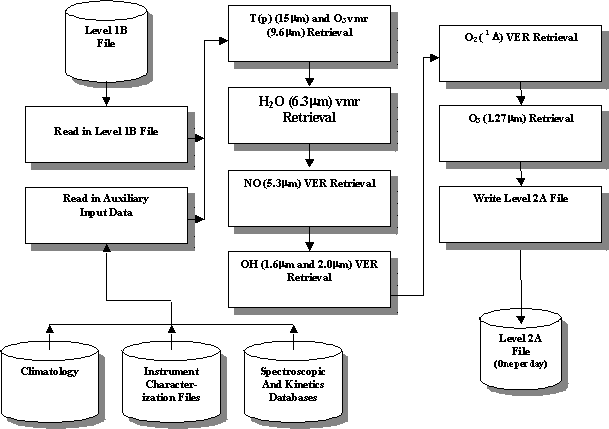
![]()
Download Level 2A Software Design Document in pdf format
This Software Design Document (SDD) describes an overall design plan for SABER Level 2A processing software. The software retrieves geophysical parameters, chemical constituents, and key emission features important in understanding the energy budget of the mesosphere and lower thermosphere. The Level 2A Routine Products are retrieved from measured radiances, read from the Level 1B file, and auxiliary input data from an instrument characterization file, climatological data, and spectroscopic and kinetics databases. The Routine Products are output to a daily NetCDF file.
The SABER Level 2A data flow is shown in Figure 1. The Level 1B file is NetCDF format and is described in the Level 1B Format Document. It contains radiance data geolocated and gridded to common angle & height scales.
The Level 2A software must be able to run on Linux workstations. It must be able to read and write files across the Internet via NFS.
This CSCI reads data from the SABER 1B file. The data are read into a format that the Level 2A system can use for processing.
The CSCI must open and read a Level 1B file. The data are stored by scanning event and channel identification number.
Use debugger to dump data read in for comparison with Level 1B file.
This CSCI reads auxiliary input data required to retrieve Level 2A Routine Data Products. The data are read into a format that the Level 2A system can use for processing.
The CSCI must open and read data from the instrument characterization file, climatological database, and the spectroscopic and kinetics databases. The auxiliary data are free ASCII format. The instrument characterization file is supplied from Level 1 processing.
Use debugger to dump data read in for comparison with auxiliary input data files.
This CSCI retrieves T, p, and O3. Other quantities computed from the retrieved T(p) are ? and z. The retrieved and computed quantities are passed to all subsequent CSCI's.
The CSCI must retrieve T, p, and O3 for each scanning event supplied by the Level 1B file. The CO2N and CO2W 15um channels are used to retrieve T and p. From the retrieved T(p), ? and z are computed.
Synthetic Level 1B radiances will be generated from a model atmosphere (e.g. from the climatology database). T(p) and O3 will be retrieved from the synthetic radiances and compared to the model atmosphere.
This CSCI retrieves H2O mixing ratio at 6.3um.
The CSCI must retrieve H2O for each scanning event supplied by the Level 1B file. The retrieved T(p) from Section 5.3 is required.
Synthetic Level 1B radiances will be generated from a model atmosphere (e.g. from the climatology database). H2O will be retrieved from the synthetic radiances and compared to the model atmosphere.
This CSCI retrieves NO VER at 5.3um.
The CSCI must retrieve NO VER for each scanning event supplied by the Level 1B file. The retrieved T(p) from Section 5.3 is required.
Synthetic Level 1B radiances will be generated from a model atmosphere (e.g. from the climatology database). NO VER will be retrieved from the synthetic radiances and compared to the model atmosphere.
This CSCI retrieves OH VER at 1.6um and 2.0um.
The CSCI must retrieve OH VER for each scanning event supplied by the Level 1B file. The retrieved T(p) from Section 5.3 is required.
Synthetic Level 1B radiances will be generated from a model atmosphere (e.g. from the climatology database). OH VER at 1.6um and 2.0um will be retrieved from the synthetic radiances and compared to the model atmosphere.
This CSCI retrieves O2 ( 1D ) VER at 1.27um.
The CSCI must retrieve O2 ( 1D ) VER for each scanning event supplied by Level 1B file. The retrieved T(p) from Section 5.3 is required.
Synthetic Level 1B radiances will be generated from a model atmosphere (e.g. from the climatology database). O2 ( 1D ) VER will be retrieved from the synthetic radiances and compared to the model atmosphere.
This CSCI retrieves O3 mixing ratio during daytime from the O2 ( 1D ) (1.27um) VER and O3 (9.6um).
The CSCI must retrieve O3 mixing ratio for daytime scanning events supplied by Level 1B file. The retrieved T(p) and O3 mixing ratio (below 50 km) from Section 5.3 is required. The retrieved O2 ( 1D ) VER from Section 5.7 is also required.
Synthetic Level 1B radiances will be generated from a model atmosphere (e.g. from the climatology database). O3 (1.27um) will be retrieved from the synthetic radiances and compared to the model atmosphere.
The CSCI writes SABER Level 2A Routine Products to NetCDF file.
The CSCI must write the Level 2A Routine Products described in Sections 5.3 through 5.8 to a NetCDF file. The Level 2A file is described in the Level 2A format document.
Read Level 2A NetCDF file and compare to an ASCII file with the same data.
| APID | Application Identifier |
| APL | Applied Physics Laboratory |
| CCSDS | Consultative Committee for Space Data Systems |
| CO2N | Carbon Dioxide Narrow Channel |
| CO2W | Carbon Dioxide Wide Channel |
| CSCI | Computer Software Configuration Item |
| GATS | G&A Technical Software |
| GIS | Geographic Information System |
| H2O | Water Vapor |
| NO | Nitric Oxide |
| NFS | Network File System |
| O2 | Oxygen |
| O3 | Ozone |
| P | Pressure |
| SABER | Sounding of the Atmosphere using Broadband Emission Radiometry |
| SDD | Software Design Document |
| T | Kinetic Temperature |
| �m | Micrometer |
| VER | Volume Emission Rate |
| VMR | Volume Mixing Ratio |
| Z | Altitude |